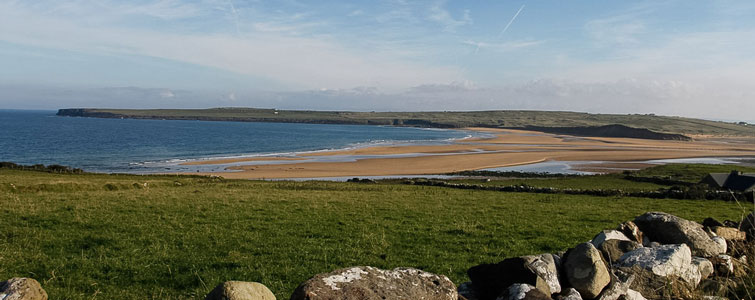Rathlacken Court Tomb Trail in Co. Mayo

The Rathlacken Court Tomb Trail starts and finishes at the picnic area beside Lacken Church.
Walkers can choose between two loops walks: the 8km long Green Loop and the 11km long Blue Loop. Both of them are archaeological, nature and scenic walks.
The loops wind along paved and bog roads, laneway and grassy tracks and cover a little section of the Western Way. They are also suitable for mountain bike use.
The features of the trails are the many sites rich in history stretching from Neolithic Era to medieval and recent times.
Through the bog walkers will be able to spot stone walls, cairns, standing stone, house structures and megalithic tombs dating back around 5500 years ago.
The Rathlacken Court Tomb can be seen very close to the route. The archaeologist Gretta Byrne discovered an integrated system of field walls equal to that at Ceide Fields, not far from here.
Here are the most interesting points along the trail walkers will come across or spot starting from the trail head.
1-LACKEN STRAND
Lacked Stand is a sheltered inlet in Lacken Bay and its scenic beauty is quite unrivalled. It is divided in two by a 2.5m2 strand and a 2m2 salt marsh that is a Special Area of Conservation. It is home to many rare birds such as curlews, lapwings and golden plovers.
At the head of the bay a standing stone can be seen in Fochill, a place associated with Sant Patrick; not far from there is Kilcummin Head where the first contingent of 200 French army men came ashore on August 22nd, 1798.
2-GREENHILL
Greenville is large circular mount visible from the trail. Numerous human bones buried in stone cists were found in the 1990’s. The bones date back to the early medieval time and now are reburied in the local cemetery.
3-LACKEN PIER
Just off the walk are the Lacken Pier and its monument erected in 1977 in remembrance of the victims of the tragedy occurred on October 28th 1927.
Nine local fishermen lost their lives. While they were out fishing herrings the sky got very dark and a storm arose. Some boats were driven out to the rocks by the raging wind. Most of the victims were never found and local fishermen call this the night of the disaster.
The pier was built around the 1890's and was part of the development of the congested areas of the West brought in by Prime Minister Balfour around 1891.
4-CILLIN
Cillin is an evocative place. Here the unbaptised children were buried in the past. It is thought also that it could be an earlier cashel.
5-RATHLACKEN COURT TOMB
This site consists of an exceptionally well preserved court tomb with three fine chambers built from massive upright stones and a circular court in front.
It was first discovered by the late Major Aldridge in the 1950s, but only between 1990 and 1997 an appropriate excavation was undertaken by the archaeologist Gretta Byrne.
The site itself is owned by Coillte who gave permission for the excavation.
It is one of the finest megalithic court tombs in Mayo and it has been built before 5,300 years ago.
In one chamber remains of what probably were cremation deposits were found, while on the site pottery of different styles and stone implements were found.
An associated house and a stone walled enclosure was built on to the side of the court tomb.
The tomb was re-used again about 4,000 years ago by Bronze Age people for burials.
6-CONAGHRA
This is the highest point of the route. From here Walkers will be able to enjoy breathtaking views over Mayo, Sligo and Donegal including Seefin, Sralagagh, Doonfeeney and Ceide. Also they can get a perspective on the sheer scale of the Neolithic landscape.
7-GAZEBO
The gazebo is a peculiar structure of rough stones overlooking the ruins of Castlelackan.
It was built in 1794 by Sir John Palmer. At that time the gentry used to picnic here and admire the magnificent views of the stunning seascape and surrounding landscape.
The mountains of Killybegs in Donegal are visible from here on a clear day, while Sligo's Ben Bulben and Knocknarea can also be seen.
In the past sailors used this obelisk as a navigational aid.
8-CASTLELACKAN DEMESNE
Castlelackan Demesne is a castle built in 1585 and visible from the Gazebo. In 1666 James Cuffe, a Cromwellian soldier, came to a stop here and built a house.
Not long afterwards the Palmer family bought it and lived there until 1916, when the castle was sold to the Congested Districts Boards.
9-LACKAN CHURCH
Lacked Church was built in 1969 on the site of an earlier church. Its main features are the stained glass windows depicting Saint Patrick’s life, the legend of the Children of Lir and the tragedy of the fishermen’s drowning occurred in 1927.
Also, the trail offers an interesting overview of the many habitats North Mayo boasts such as blanket bog, wet grassland, sand dunes, salt marshes, farmland, forestry and heathland.
On the seashore many species of birds can be seen; curlews, skylarks, sand martins, plovers, kestrels, oystercatchers, snipes, mallards and gulls.
Land is home to hares, foxes, badgers, lizards and pine martins.
Many species of plants can be spotted: wild thyme, orchids, thrift, eelgrass, sea asters in the salt marshes, while in the bog walkers will find mosses, heathers, lichens, milkworts, bog cotton and sundews.
